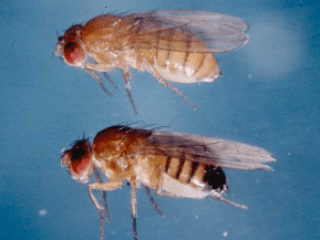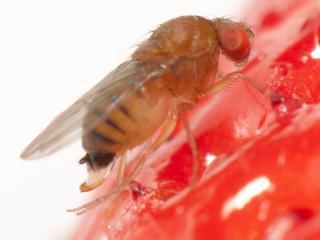
It is not the strongest of the species that survives, or the most intelligent ; it is the one most capable of change
Mots clés: Plasticité phénotypique, Biologie de l'invasion, Température, Drosophila
News
https://genestogenomes.org/in-memoriam-jean-r-david-1931-2021/

Phenotypic plasticity and adaptive responses to environmental change
My research work has allowed me to explore different aspects concerning the adaptive responses of organisms to environmental changes, mainly temperature, on the insect model and especially on Drosophila through a comparative approach. I was particularly interested in phenotypic plasticity which can be defined as the ability of a genotype to produce different phenotypes according to environmental conditions. Phenotypic plasticity is a phenomenon that can be generalized to all living organisms and that can be found in all species and for a wide variety of phenotypic traits.
The main questions addressed during my research are :
How to analyze the shapes of non-linear reaction norms? Do these reaction norms present genetic variability? How do these norms evolve between populations and between species? Do these comparisons provide arguments for adaptive phenotypic plasticity?
How will environmental variability (thermal fluctuation) impact the shape of response norms? What about environmental complexity (combination of several factors)?
What is the importance of phenotypic plasticity as a response mechanism to environmental perturbations?

Drosophila suzukii: a recent biological invasion and a major economic threat
For the past few years, my research activity has focused on a project concerning a very recent biological invasion event involving a fruit crop pest, Drosophila suzukii. At the fundamental level, we were first interested in the ecological factors that explain the invasive success of this species whose biology was poorly known. We showed that French larval parasitoids were unable to control D. suzukii populations because of its very high immune resistance capacity. We also showed that this species has a very wide range of wild host plants present throughout the year and we highlighted an interesting case of self-medication in D. suzukii. Moreover, our results suggest that if D. suzukii does not really have competitors on healthy fruits, it can undergo a strong larval competition with D. melanogaster on rotten fruits on which an oviposition avoidance behavior is observed. Current projects aim to use the recent and spectacular invasion of D. suzukii to better understand the mechanisms of adaptation to a new environment, in particular the role of phenotypic plasticity. Finally, some projects have also been developed to consider new control methods against this formidable crop pest.
Ongoing projects
ANR SWING project: Genetics, plasticity and evolutionary potential of Drosophila suzukii
L’objectif général de ce projet que je porte et qui est réalisé en collaboration avec
The general objective of this project, which I lead and which is carried out in collaboration with Vincent Debat (ISyEB, MNHN), Simon Fellous et Arnaud Estoup (CBGP Montpellier) and Cristina Vieira (LBBE), is to study the evolutionary processes at play during a biological invasion with a focus on the mechanisms of adaptation. We are also interested in the evolutionary potential of the invasive species in order to predict its capacity to adapt in the short and medium term. Thus, the different components are 1) to quantify the phenotypic variation of native and invasive populations using quantitative genetic methods and the study of reaction norms; 2) to characterize, at the genomic and transcriptomic level, the genetic basis of adaptation during the invasion process by determining the relative importance of natural selection and genetic drift on the phenotypic differentiation between native and invasive populations; 3) to combine these phenotypic and molecular approaches in order to better understand which traits are associated with invasion success, and to analyze the role of transposable elements in adaptation; 4) to evaluate the agronomic consequences of the plasticity and rapid adaptation capacity of D. suzukii.
ANR CRASHPEST project : A cascade of destabilizations: combining Wolbachia and Allee effects to eradicate the insect pest Drosophila suzukii
This project led by Laurence Mouton (LBBE) in collaboration with Emmanuel Desouhant (LBBE) and Xavier Fauvergue (ISA, Sophia Antipolis) aims to develop a method of control of D. suzukii based on the manipulation of processes intrinsic to populations, the meeting and compatibility of sexual partners, combining mating disruption and inoculation of bacteria of the genus Wolbachia.
ANR DroThermal project : What makes Drosophila suzukii such an effective invader ? an integrative analyses of its thermal ecology
The objective of DroThermal, led by Hervé Colinet (ECOBIO, Rennes), is to integrate different levels of variation across different spatio-temporal scales in order to better understand the thermal responses of Drosophila suzukii and thus to better predict the persistence and dynamics of populations at both local and global levels. This project will be carried out in collaboration with Sylvain Pincebourde (IRBI) for spatial variations, Olivier Chabrerie (EDYSAN) for trophic variations and Laurence Mouton (LBBE) for the integration of host-microbe interactions.
ANR LongevitY project : Exploring the contribution of sex chromosomes to male-female differences in aging and longevity
This project led by Cristina Vieira (LBBE) is a federative project at the laboratory level because it involves researchers from the four departments of the LBBE working on different aspects of aging and on various biological models (birds and large mammals, humans, Drosophila).
The main objective of the project is to test the contribution of sex chromosomes to the sex gap longevity (SGL). The underlying hypothesis is that in species with sex chromosomes, all deleterious recessive mutations are expressed on the single X chromosome in males and may reduce their lifespan, the so-called unprotected X effect. In addition, the many transposable elements (TEs) on the Y chromosome can affect aging. The activity of TEs is normally suppressed by epigenetic regulation (DNA methylation, histone modifications and small RNAs). However, it is known that this regulation is disrupted with age. Due to the Y chromosome, more ETs can become active in aged males than in aged females, generating more somatic mutations, accelerating aging and reducing lifespan in males, the so-called Y-toxic effect. My participation in this project will focus on characterizing the toxic effects of Y in different species and populations of Drosophila.
Responsabilités
Présidente du CS INEE
Responsable du Pôle Biodiversité de la FR BioEEnViS
Responsable du DIPEE Lyon St-Etienne
Publications
Display of 91 to 113 publications on 113 in total
The stength of phenotypic selection in natural population
The American Naturalist . 157 : 245-261
Journal article
see the publicationChill coma tolerance: a major climatic adaptation among Drosophila species
Evolution - International Journal of Organic Evolution . 55 : 1063-1068
Journal article
see the publicationLocomotor performance of Drosophila melanogaster: interactions among developmental and adult temperatures age and geography
Evolution - International Journal of Organic Evolution . 55 : 205-209
Journal article
see the publicationChill-coma temperature in Drosophila: effects of developmental temperature latitude and phylogeny
Physiological and Biochemical Zoology . 74 : 429-434
Journal article
see the publicationTemperature dependence rate of developmental rate and adult size in Drosophila species: biophysical parameters
Journal of Evolutionary Biology . 14 : 267-276
Journal article
see the publicationViability and rate of development at different temperatures in Drosophila: a comparison of constant and alternating thermal regimes
Journal of Thermal Biology . 26 : 29-39
Journal article
see the publicationThe genetics of Phenotypic plasticity. IX. Genetic architecture and sex differences in Drosophila melanogaster
Evolution - International Journal of Organic Evolution . 54 : 1035-1040
Journal article
see the publicationDevelopmental constraints on an adaptive plasticity: reaction norms of body pigmentation in adult segments of Drosophila melanogaster
Evolution and Development . 2 : 249-260
Journal article
see the publicationPhenotypic plasticity of abdominal pigmentation in D. kikkawai : multiple interaction between a major gene sex abdomen segment and growth temperature
Genetica . 105 : 165-176
Journal article
see the publicationPhenotypic plasticity of body pigmentation in Drosophila: correlated variations between segments
Genetics Selection Evolution . 30 ( 2 ) : 181-194
Journal article
see the publicationDesiccation and starvation tolerance of adults Drosophila : opposite latitudinal clines in natural populations of three different species
Evolution - International Journal of Organic Evolution . 52 : 825-831
Journal article
see the publicationLight body pigmentation in Indian D. melanogaster : a likely adaptation to a hot and arid climate
Journal of Genetics . 77 : 13-20
Journal article
see the publicationDescribing the evolution of reaction norm shape : body pigmentation in Drosophila
Evolution - International Journal of Organic Evolution . 52 : 1501-1506
Journal article
see the publicationPhenotypic plasticity of body pigmentation in Drosophila : correlated variations between segments
Genetics Selection Evolution . 30 : 181-194
Journal article
see the publicationPhenotypic plasticity and developmental temperature in Drosophila : analysis and significance of reaction norms of morphometrical traits
Journal of Thermal Biology . 22 : 441-451
Journal article
see the publicationGenetic variability of quantitative traits in Drosophila melanogaster (fruit fly) natural populations: analysis of wild-living flies and of several laboratory generations
Heredity . 80 : 326-335
Journal article
see the publicationCold stress tolerance in Drosophila : analysis of chill coma recovery in D. melanogaster
Journal of Thermal Biology . 5 : 291-299
Journal article
see the publicationThoracic trident pigmentation in Drosophila melanogaster : latitudinal and altitudinal clines in Indian populations
Genetics Selection Evolution . 29 : 601-610
Journal article
see the publicationEvolutionary changes of non linear reaction norms according to thermal adaptation : a comparison of two Drosophila species
Comptes rendus de l’Académie des sciences. Série III, Sciences de la vie . 320 : 833-841
Journal article
see the publicationLatitudinal clines for morphometrical traits in Drosophila kikkawai : a study of natural populations from the Indian subcontinent
Genetical Research . 71 : 31-38
Journal article
see the publicationDrosophilids from an arid Afrotropical country the Republic of the Niger : faunistics and phenotypic plasticity
Drosophila Information Service . 77 : 115-117
Journal article
see the publicationGrowth temperature and adult pigmentation in two Drosophila sibling species : an adaptive convergence of reaction norms in sympatric populations ?
Evolution - International Journal of Organic Evolution . 50 : 2346-2353
Journal article
see the publicationNew discriminating traits between females of two sibling species: textit Drosophila melanogaster and D. simulans (Diptera Drosophilidae)
Annales de la Société Entomologique de France . 31 : 249-257
Journal article
see the publication